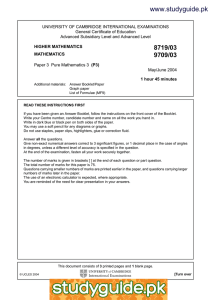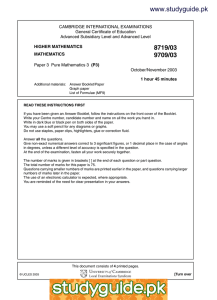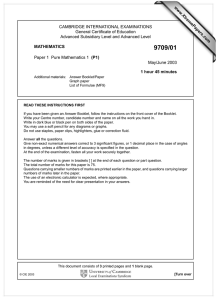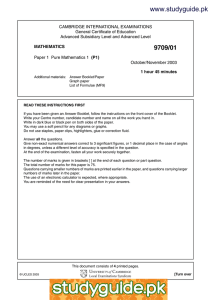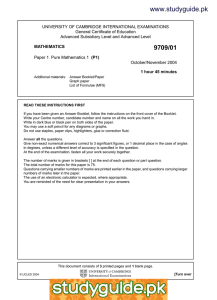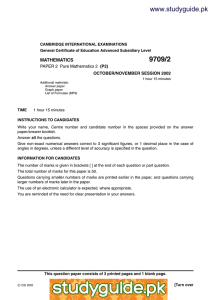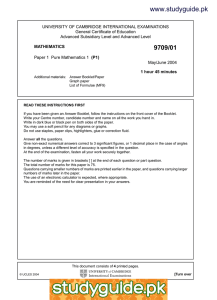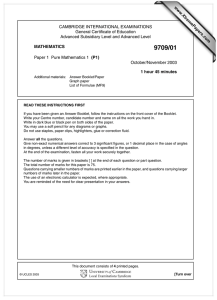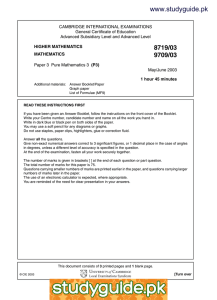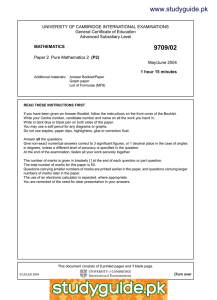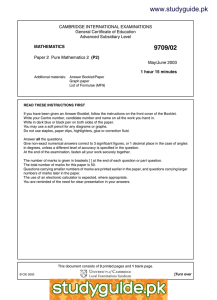www.studyguide.pk
advertisement
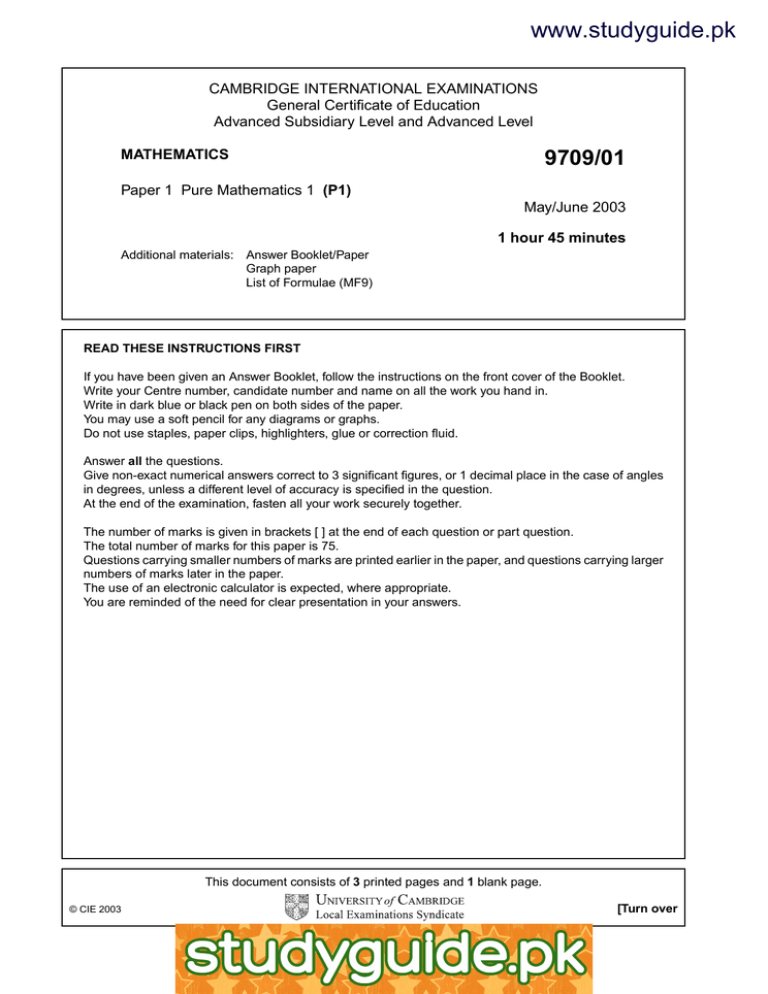
www.studyguide.pk CAMBRIDGE INTERNATIONAL EXAMINATIONS General Certificate of Education Advanced Subsidiary Level and Advanced Level MATHEMATICS 9709/01 Paper 1 Pure Mathematics 1 (P1) May/June 2003 1 hour 45 minutes Additional materials: Answer Booklet/Paper Graph paper List of Formulae (MF9) READ THESE INSTRUCTIONS FIRST If you have been given an Answer Booklet, follow the instructions on the front cover of the Booklet. Write your Centre number, candidate number and name on all the work you hand in. Write in dark blue or black pen on both sides of the paper. You may use a soft pencil for any diagrams or graphs. Do not use staples, paper clips, highlighters, glue or correction fluid. Answer all the questions. Give non-exact numerical answers correct to 3 significant figures, or 1 decimal place in the case of angles in degrees, unless a different level of accuracy is specified in the question. At the end of the examination, fasten all your work securely together. The number of marks is given in brackets [ ] at the end of each question or part question. The total number of marks for this paper is 75. Questions carrying smaller numbers of marks are printed earlier in the paper, and questions carrying larger numbers of marks later in the paper. The use of an electronic calculator is expected, where appropriate. You are reminded of the need for clear presentation in your answers. This document consists of 3 printed pages and 1 blank page. [Turn over © CIE 2003 www.xtremepapers.net www.studyguide.pk 2 1 1 5 in the expansion of 2x − . x x 1 Find the value of the coefficient of 2 Find all the values of x in the interval 0◦ ≤ x ≤ 180◦ which satisfy the equation sin 3x + 2 cos 3x = 0. [4] 3 (a) Differentiate 4x + (b) Find 4x + 6 with respect to x. x2 6 dx. x2 [3] [2] [3] 4 In an arithmetic progression, the 1st term is −10, the 15th term is 11 and the last term is 41. Find the sum of all the terms in the progression. [5] 5 The function f is defined by f : x → ax + b, for x ∈ , where a and b are constants. It is given that f(2) = 1 and f(5) = 7. 6 (i) Find the values of a and b. [2] (ii) Solve the equation ff(x) = 0. [3] (i) Sketch the graph of the curve y = 3 sin x, for −π ≤ x ≤ π . [2] The straight line y = kx, where k is a constant, passes through the maximum point of this curve for −π ≤ x ≤ π . (ii) Find the value of k in terms of π . [2] (iii) State the coordinates of the other point, apart from the origin, where the line and the curve intersect. [1] 7 8 The line L1 has equation 2x + y = 8. The line L2 passes through the point A (7, 4) and is perpendicular to L1 . (i) Find the equation of L2 . [4] (ii) Given that the lines L1 and L2 intersect at the point B, find the length of AB. [4] The points A, B, C and D have position vectors 3i + 2k, 2i − 2j + 5k, 2j + 7k and −2i + 10j + 7k respectively. (i) Use a scalar product to show that BA and BC are perpendicular. [4] (ii) Show that BC and AD are parallel and find the ratio of the length of BC to the length of AD. [4] 9709/01/M/J/03 www.xtremepapers.net www.studyguide.pk 3 9 The diagram shows a semicircle ABC with centre O and radius 8 cm. Angle AOB = θ radians. (i) In the case where θ = 1, calculate the area of the sector BOC. [3] (ii) Find the value of θ for which the perimeter of sector AOB is one half of the perimeter of [3] sector BOC. (iii) In the case where θ = 13 π , show that the exact length of the perimeter of triangle ABC is √ (24 + 8 3) cm. [3] 10 √ The equation of a curve is y = (5x + 4). (i) Calculate the gradient of the curve at the point where x = 1. [3] (ii) A point with coordinates (x, y) moves along the curve in such a way that the rate of increase of x has the constant value 0.03 units per second. Find the rate of increase of y at the instant when x = 1. [2] (iii) Find the area enclosed by the curve, the x-axis, the y-axis and the line x = 1. 11 [5] The equation of a curve is y = 8x − x2 . (i) Express 8x − x2 in the form a − (x + b)2 , stating the numerical values of a and b. [3] (ii) Hence, or otherwise, find the coordinates of the stationary point of the curve. [2] (iii) Find the set of values of x for which y ≥ −20. [3] The function g is defined by g : x → 8x − x2 , for x ≥ 4. (iv) State the domain and range of g−1 . [2] (v) Find an expression, in terms of x, for g−1 (x). [3] 9709/01/M/J/03 www.xtremepapers.net www.studyguide.pk 4 BLANK PAGE 9709/01/M/J/03 www.xtremepapers.net
